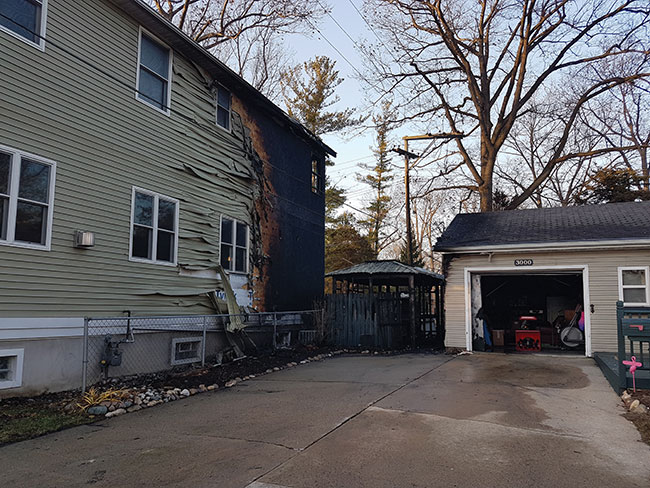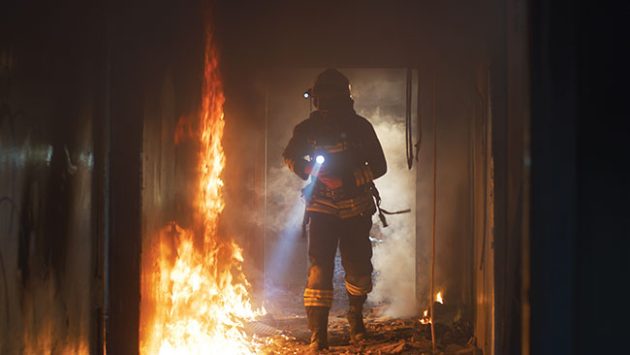
Features
Back to Basics: The tenets of VES
July 19, 2022
By Mark van der Feyst
 VES is designed and meant to be used for a single room only. It is a search of a single room and not the entire floor of the structure.
Photo credit: Mark van der Feyst
VES is designed and meant to be used for a single room only. It is a search of a single room and not the entire floor of the structure.
Photo credit: Mark van der Feyst On the fire ground, when responding to a residential structure fire, the fire service resorts to tactics to accomplish important tasks and priorities. Just like a football coach who has a play book with different set ups, plays and calls for the game, the fire service has a tactics book.
One such tactic is VES or VEIS – even though they are different by a letter, the two are the exact same thing. The original term is VES and through time, with some contribution from other people, VEIS was adopted.
VES stands for Vent, Enter, Search and VEIS stands for Vent, Enter, Isolate, Search. For this article, I am going to use the term VES – let us look at the tenets of what VES is and how it can be used by any fire department.
Firstly, VES is “a” tactic but not the only tactic. Fire departments and firefighters cannot rely on only one tactic as the be all, end all. When new tactics are introduced, people seem to rely on them as the only one to use – but the opposite is true. The one tactic is added to the others so that when arriving on scene, the appropriate tactic can be selected and deployed. Firefighters cannot rely on VES for every situation – although it is very versatile and adaptable to be used.
VES is a tactic that is designed for staff limited situations. VES works best with two firefighters. Having three firefighters on a team performing this can be done, but it becomes crowded in the room and with the sequence of operations. Many smaller fire departments will respond with two firefighters on an engine and will find themselves struggling to keep up with limited hands available. If the engine has four firefighters arriving on it, the team can be split into two teams of two to perform this.
This tactic is also designed and meant to be used by the first arriving unit on scene. The goal of VES is to perform a rapid rescue of an occupant. This rapid rescue will and must occur in the first five minutes of arriving on scene. The greatest chance of survival for the occupant is going to happen within this window of opportunity. Any delay in the rescue after the first five minutes could be detrimental to the occupant.

One of the key aspects of VES is knowing the location of the occupant within a room of the structure. Photo by Adobe Stock / Framestock
One of the key aspects of VES is the known location of the occupant within a room of the structure. This will be based upon witness statements from other family members, neighbours or even the occupant themselves calling 911. Having a witness state that there is a person in a particular room is going to verify the presence of that person and validate the need to use VES to perform the rapid rescue. Neighbours will most likely know the habits or schedules of the occupant, so they can identify if they will be home or not. If they are home, the neighbour may be able to point out which room the occupant is in.
VES works best with a known location of the occupant – this part also includes knowing building construction and being able to read a building. If we are told that a person is still in their bedroom, but they don’t know which bedroom it is, the firefighter needs to be able to identify where the bedrooms are in the house by reading the building. Window locations and types are going to assist with this along with the number of stories the house has. Many occupants are found in their bedrooms on the floor by the bedroom door, the window or in their bed.
Occupants that are still in the structure need to be viable for rescue. What this refers to is the amount of time exposed to the conditions and the extent of the conditions in relation to their location. Sizing up the fire and the building will play an important role in the decision to use VES. The fire conditions of the structure and the location of the fire will dictate if the occupant will be able to survive the exposure. If the room in question is fully involved with fire and self-venting out the window, any occupant in that room will not be viable for rescue as opposed to a fire in a room next to or below the occupant’s room.
Lastly, VES is designed and meant to be used for a single room only – it is a search of a single room and not the entire floor of the structure. If a primary search takes place by entering a window and then searching the entire floor, this is not VES. Entering by the window and searching only the room in question is VES – this tactic is an assistant to the primary search.
Many fire departments are still considering whether to include VES as part of their tactics play book. Hopefully this information will assist in their decision to adopt this tactic. In our next issue, we will explore the practical portion of this VES.
Mark van der Feyst has been in the fire service since 1999 and is currently a firefighter with the FGFD. Mark is an international instructor teaching in Canada, U.S. FDIC and India. He is the lead author of Fire Engineering’s Residential Fire Rescue & Tactical Firefighter books. Contact him at Mark@FireStarTraining.com
Print this page